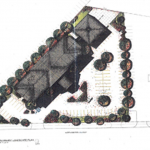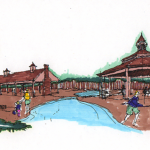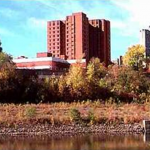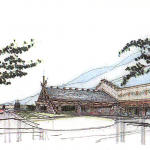|
Land Acquisition & Due Diligence
Buying land for real estate development purposes will become more difficult, complex, and risky for residential and non-residential developers.
There have been many changes in buying and assessing land for development purposes. Most of the recent changes are due to the great recession and lending practices. It hasn’t always been this way and over the past four decades, our approach to buying land remains about the same EXCEPT for governments influence:
“Buy land in the best location at below market prices and rezone for value”
The knocking on doors and asking the land owner to sell still may happen but most likely, the land owner will know more about the market price for their land than you! Unfortunately, they will think their property is always worth more than it is from a development point of view. In this case it is their estate that will sell the land!
The information found on the internet is remarkable and an internet property search before walking the property can save you a lot of time and effort. Land acquisition is a local /regional enterprise with its own unique land evaluation approach because of land form and characteristics. But the approach to assess land for development potential remains the same. I am posting my due diligence checklist for your use. In previous blog posts, I have explained each task. Please add your tasks to this list or delete tasks to make this checklist specific to you. The due diligence period is part of the land acquisition process and “kicking the tires” take time, effort and financial risk.
Due Diligence Checklist
GENERAL
· Property Description and Ownership
· Tax Map and Parcel Size
· Master Plan Compliance
· Future Road Alignments & Right-of-Way Dedications
· Review of Phase I Environmental Study, if available
· Walk the Site & Pictures
MAPS & PLANS
· Property Boundary Survey
· Tax Map
· Zoning Map
· Master Plans
· Street Map and Community Amenities
· Topographic Survey or Graphic Information Systems (GIS)
· Aerial Photo
· Soils
· Water and Sewer Maps
· Wetland Inventory Maps
· Flood Plain Maps
· Road Network Plan
ZONING & LAND USES
· Zoning Designation
· Permitted and Conditional Uses
· Zoning Restrictions, Bulk Requirements, and Constraints
· Density Bonus
· Yield Analysis, Open Space and Buffer Requirements
REGULATORY
· Current Rezoning Applications
· Development Impact on Services & Existing Infrastructure
· Dedications, Easements and Encroachments
· Road Access, Offsite Road Improvements & Onsite Road Circulation
· Land Development Regulations
· Storm water Management Facility Requirements
· Best Management Practices
· Entitlement, Approval and Permitting Process
NEIGHBORING PROPERTY (N.I.M.B.Y. ism issues?)
– Existing and Proposed Uses
· Positive and Negative Surrounding Property Analysis
· Neighborhood Reaction to Development Plans
· Political Assessment
SITE CHARACTERISTICS
· Flood Plains
· Environmental Constraints
· Wetlands, Ponds and Jurisdictional Streams
· SWIM Buffers, Natural Buffers
· Property Soil Types and Characteristics impacting development potential
· Water Table
· Topography and Slope Analysis
· Drainage Patterns, Conveyance and Site Characteristics
· Water Line and Fire Hydrant Location, Water Pressure, and Availability
· Sewer Line Location and Invert Elevations, Line and Plant Capacity
· Other Utility Availability i.e. gas, electric, telephone, fiber optics
· Frontage Road Classification, Condition and Sight Distance
· Property Configuration Impacting Development
· Connection to Adjacent Properties (Connectivity)
· Soil Erosion and Sedimentation Control Issues
· Watershed Protection Areas Requirements
· Existing Vegetation and Specimen Trees
· Existing Site Buildings, Condition and Demolition Requirements
GOVERNMENT STAFF COMMENTS
· Planning & Zoning Department
· Engineering Department
· Public Works
· Water and Sewer Departments
· Building Department
· Police Department
· Fire Department
DEVELOPMENT POTENTIAL ANALYSIS – HIGHEST & BEST USE
LAND PLAN CONCEPT
VALUE ANALYSIS
As we come out of the great recession, land remains the most valuable resource as our population continues to increase. Baby Boomers (79 million and about 10,000 retire per day! and Generation Y or “New Boomers” (71 million strong) will influence our real estate development decisions and our search for land. Where will people live in the future – rural, suburban, or urban settings? Each of these distinct geographic areas in your market presents a different set of circumstances.
Besides regulations and government restricting land, there are several key site characteristics which will be essential to your property investigation. Every market will have its own unique issues to be investigated during due diligence phase but the following have national ramifications on real estate resurgence over the long term.
1. Wetlands and flood plains reduce buildable area and may extend permitting time and design complexities. New flood plain mapping has been ongoing through the great recession. New elevations and flood plain limits have been and are being reestablished. Local governments are establishing their own flood plain limits layered over top of the Federal Emergency Management Association (FEMA) maps. The definition and assessment of wetland areas continues to be problematic. Do you really think that it will become easier due to environmental protection or the definition will become less restrictive? Phase I reports will remain an element of our lending practices.
2. Sewer will be the issue of the decade. If you have a sewer line in front of your property doesn’t mean that you will be permitted to connect. Just because a sewer line can be extended to service your property doesn’t mean that you will receive a permit to do so. Why? It is not the truck line that is the problem, although it may be undersized. Waste water treatment plant capacity is and will be the problem for future development. Your due diligence approach has to be extensive and you have to ask the correct questions. There are plenty of “approved and unimproved” projects on the shelf in many markets. Most of these projects which would be serviced by public sewer and the owners have reserved plant capacity. Therefore a waste water treatment plant that is at 100% capacity may only be at 70% and 30% reserved for projects that have paid their fees. Or, the worst case scenario is that there is limited capacity available at the plant and there are NO plans for expansion. In many markets, “sewer moratorium” will again enter our land acquisition terminology.
3. Soil characteristics of a site have always have been a site analysis requirement. Soils are also a key determining factor on the earthwork costs of a project. As the “good land” has disappeared from the market for many reasons, the available properties have soil issues. The days of walking the property and digging your heal into the ground to assess it characteristics is no longer acceptable. Then we used soils maps which are excellent for planning purposes but not extremely accurate. Then we spent some money on test pits on selected areas. Then we spend money on soil borings on selected areas. Then we prepared a soils analysis investigation program combining everything at our disposal. And, in the end, we will still not know everything about the property as we should to consider the property for purchase. Site analysis work is undertaken to reduce risk.
4. Roads along the property frontage and offsite will be issues for your project much more in the future than ever before. It is conceivable that local governments will use the development community to repair, maintain and build roads just because a developer wants to build a project.
When was the last time your local jurisdiction built a road?
When was the last time you local jurisdiction repaved a road?
Does your local jurisdiction have the funds even to maintain the roads?
Ownership, quality, maintenance, turnover, pavement design, inspection, bonding, design criteria, capacity studies, traffic studies may change now or in the near futures. The pent-up demand for housing and non-residential projects will cause local, state, and federal government agencies to put more and more of the road network burden on the developer.
Contracts – the purchase of property will not be any easier in the future simply because of the risks due to property characteristics, government regulations and property owner sophistication. Time will be the governing factor in bringing on projects online without the commitment of an outright purchase. We will have to approach land acquisition differently while managing cash flow during the regulatory and permitting process. Perhaps it is time for more land owners to sit in on the deal!
Finding and buying land for large scale projects that make a significant industry wide statement may be only available to a select few or those partnering with the land owner AND/OR government!
_________________________________________________________________
Principles of Good Practice we believe that adherence to the Community Development Society’s Principles of Good Practice are essential to sound community development.
- Promote active and representative participation toward enabling all community members to meaningfully influence the decisions that affect their lives.
- Engage community members in learning about and understanding community issues, and the economic, social, environmental, political, psychological, and other impacts associated with alternative courses of action.
- Incorporate the diverse interests and cultures of the community in the community development process; and disengage from support of any effort that is likely to adversely affect the disadvantaged members of a community.
- Work actively to enhance the leadership capacity of community members, leaders, and groups within the community.
- Be open to using the full range of action strategies to work toward the long-term sustainability and well being of the community.
________________________________________________________
New Development Complexities Demand New Approaches for Success Even though every land development project is unique and all have a variety of hurdles to overcome, the land development process is no longer well defined or rather simple, as in the past. Today, projects have become increasingly complex due predominately to increasing regulations and a more engaged public. That complexity results in more individuals being involved in almost every phase of a more specialized process, each of whom brings a wider range of personalities, technical knowledge, and opinions to the table.
Today , meeting zoning codes often represent just one hurdle to receiving permits. The typical development project must fulfill requirements for stormwater management, erosion, and sediment control, and receive permission and/or permits from a municipal body that often requires the meeting of one or more environmental, smart growth, new urbanist, green building, and/or sustainability initiatives…not to mention public and community support. To accomplish all of these additional challenges in the process, in an efficient and cost-effective manner, the process had to change. For many, that change has been difficult.
Gaining Critical Buy-in
Most of the added complexity is a result of more people representing different stakeholders and bringing a variety of agendas to the table, whether or not the developer asks for them. Dealing with these agendas after projects are designed and processed often delays entitlements and creates financing problems. Since time delays get very expensive, one of the best proven strategies is bringing all of the stakeholders together for one or more meetings at the outset of the project. In fact, it is best to get everyone in a room before the project has even been designed. This has many benefits, particularly from a total cost standpoint to a developer. By developing and achieving broad stakeholder buy-in of a comprehensive project vision before moving forward with project design, it is amazing how many problems can be avoided before they arise.
Selecting the Right Project Team
One of the early changes that benefits development efforts is how developers select project team members. Selecting engineers, landscape architects, architects, etc. by the lowest bid is often a recipe for trouble. In many instances, you get what you pay for and project costs end of higher in the end.
On numerous occasions I have had developers complain to me that they could not get their engineer to come to the site before the property was platted or during stakeout. They said that some errors were made during the process, but they were not caught because the engineer did not make a site visit. When the mistakes were eventually noticed, the costs to make corrections were substantial.
I confirmed with the developers that they had been responsible for hiring their engineer. When I suggested that all they needed to do was to require a site visit by the engineer as part of the job, they claimed that none of the engineers they knew would do that. I eventually found out that the developer had low-balled each of the engineering firms before selecting one – so the firms had eliminated the site visits as a portion of the contract. Thus, the developer actually created the problem for himself and it cost him dearly as some cut and fill work, as well as road cuts, were made in the wrong place and had to be redone.
The benefits of selecting project team members that philosophically support your vision and that you will actually like to work with are tremendous. Checking references and conducting interviews is a critically important part of the process. You are likely about to spend millions of dollars on your project. Finding the right members for your project team are perhaps the most important decision you will make.
The Starting Line-up
A good starting point of stakeholders for the initial gathering will likely include others beyond those you are paying to be there, such as:
– The Developer
– Construction Manager(s)
– Project Engineer(s)
– Landscape Architect(s)
– General Contractor
– Primary sub-contractors
– Municipal official representative (city planning, council, commission)
– Permitting authority
– Neighborhood / community group(s)
– Financial stakeholders(s)
____________________________________________________________ |






Connect
Connect with us on the following social media platforms.